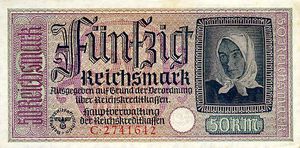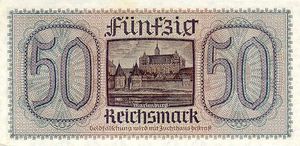Germany (Nazi / Third Reich)
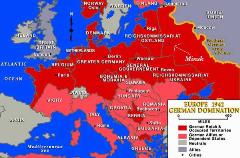
 Nazi Germany, also known as the Third Reich, is the common name for Germany when it was a totalitarian state ruled by Adolf Hitler and his National Socialist German Workers' Party (NSDAP). On 30 January 1933 Hitler became Chancellor of Germany, quickly eliminating all opposition to rule as sole leader. The state idolized Hitler as its Führer ("leader"), centralizing all power in his hands. Top officials reported to Hitler and followed his policies, but they had considerable autonomy. The government was not a coordinated, cooperating body, but rather a collection of factions struggling to amass power and gain favor with the Führer. In the midst of the Great Depression, the Nazi government restored prosperity and ended mass unemployment using heavy military spending and a mixed economy of free-market and central-planning practices. Extensive public works were undertaken, including the construction of the Autobahns. The return to prosperity gave the regime enormous popularity; the suppression of all opposition made Hitler's rule mostly unchallenged. Racism, especially antisemitism, was a main tenet of society in Nazi Germany. Germany made increasingly aggressive demands, threatening war if they were not met. Britain and France responded with appeasement, hoping Hitler would finally be satisfied. Austria was annexed in 1938, and the Sudetenland was taken via the Munich Agreement in 1938, with the rest of Czechoslovakia taken over in 1939. Hitler made a pact with Joseph Stalin and invaded Poland in September 1939, starting World War II. In alliance with Benito Mussolini's Italy, Germany conquered France and most of Europe by 1940, and threatened its remaining major foe: Great Britain. Reich Commissariats took brutal control of conquered areas, and a German administration termed the General Government was established in Poland. Concentration camps, established as early as 1933, were used to hold political prisoners and opponents of the regime. The number of camps quadrupled between 1939 and 1942 to 300+, as slave-laborers from across Europe, Jews, political prisoners, criminals, homosexuals, gypsies, the mentally ill and others were imprisoned. The system that began as an instrument of political oppression culminated in the mass genocide of Jews and other minorities in The Holocaust. Following the German invasion of the Soviet Union in 1941, the tide turned against the Third Reich in the major military defeats of the Battle of Stalingrad and the Battle of Kursk in 1943. The Soviet counter-attacks became the largest land battles in history. Large-scale systematic bombing of all major German cities, rail lines and oil plants escalated in 1944, shutting down the Luftwaffe (German Air Force). Germany was overrun in 1945 by the Soviets from the east and the Allies from the west. The victorious Allies initiated a policy of denazification and put the surviving Nazi leadership on trial for war crimes at the Nuremberg Trials. (© Wikipedia)
Nazi Germany, also known as the Third Reich, is the common name for Germany when it was a totalitarian state ruled by Adolf Hitler and his National Socialist German Workers' Party (NSDAP). On 30 January 1933 Hitler became Chancellor of Germany, quickly eliminating all opposition to rule as sole leader. The state idolized Hitler as its Führer ("leader"), centralizing all power in his hands. Top officials reported to Hitler and followed his policies, but they had considerable autonomy. The government was not a coordinated, cooperating body, but rather a collection of factions struggling to amass power and gain favor with the Führer. In the midst of the Great Depression, the Nazi government restored prosperity and ended mass unemployment using heavy military spending and a mixed economy of free-market and central-planning practices. Extensive public works were undertaken, including the construction of the Autobahns. The return to prosperity gave the regime enormous popularity; the suppression of all opposition made Hitler's rule mostly unchallenged. Racism, especially antisemitism, was a main tenet of society in Nazi Germany. Germany made increasingly aggressive demands, threatening war if they were not met. Britain and France responded with appeasement, hoping Hitler would finally be satisfied. Austria was annexed in 1938, and the Sudetenland was taken via the Munich Agreement in 1938, with the rest of Czechoslovakia taken over in 1939. Hitler made a pact with Joseph Stalin and invaded Poland in September 1939, starting World War II. In alliance with Benito Mussolini's Italy, Germany conquered France and most of Europe by 1940, and threatened its remaining major foe: Great Britain. Reich Commissariats took brutal control of conquered areas, and a German administration termed the General Government was established in Poland. Concentration camps, established as early as 1933, were used to hold political prisoners and opponents of the regime. The number of camps quadrupled between 1939 and 1942 to 300+, as slave-laborers from across Europe, Jews, political prisoners, criminals, homosexuals, gypsies, the mentally ill and others were imprisoned. The system that began as an instrument of political oppression culminated in the mass genocide of Jews and other minorities in The Holocaust. Following the German invasion of the Soviet Union in 1941, the tide turned against the Third Reich in the major military defeats of the Battle of Stalingrad and the Battle of Kursk in 1943. The Soviet counter-attacks became the largest land battles in history. Large-scale systematic bombing of all major German cities, rail lines and oil plants escalated in 1944, shutting down the Luftwaffe (German Air Force). Germany was overrun in 1945 by the Soviets from the east and the Allies from the west. The victorious Allies initiated a policy of denazification and put the surviving Nazi leadership on trial for war crimes at the Nuremberg Trials. (© Wikipedia)
MILITARY MONEY
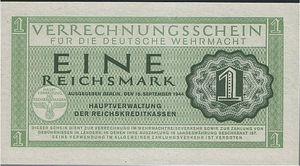
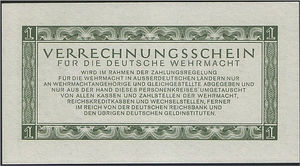
- Nominale waarde: 1 Reichsmark
- Picknummer: M38
- Jaar van uitgifte: 1944
- Serienummer in eigen collectie: --
- Voorzijde: Duitse adelaar met swastika
- Achterzijde: tekst waarin aangegeven wordt dat dit biljet voor betalingen binnen de wehrmacht is.
OCCUPIED TERRITORIES
50 Pfennig - R135
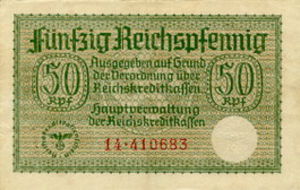
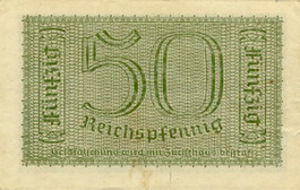
1 Reichsmark - R136
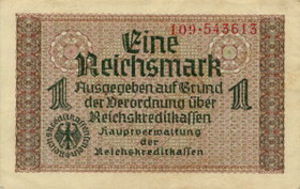
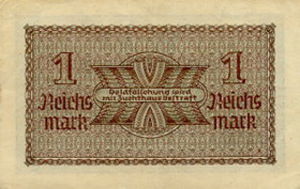
2 Reichsmark - R137
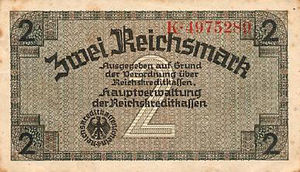
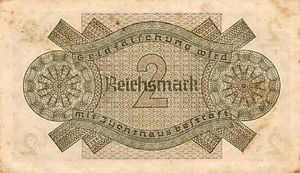
5 Reichsmark - R138
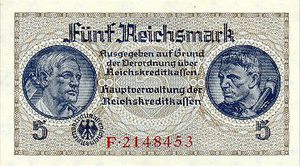
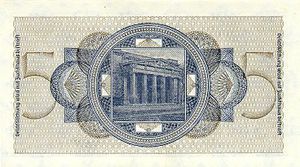
20 Reichsmark - R139
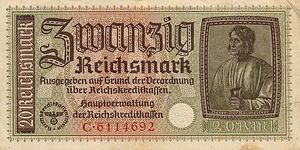
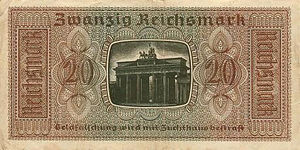
50 Reichsmark - R140
